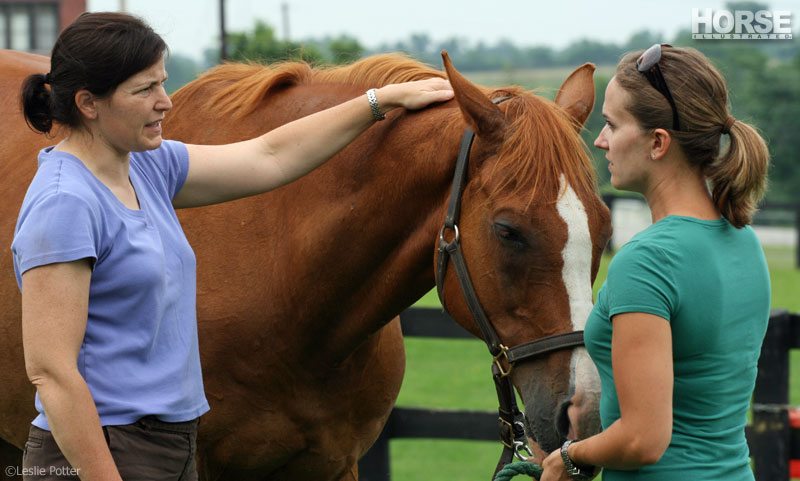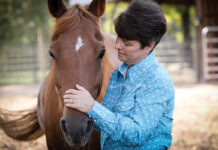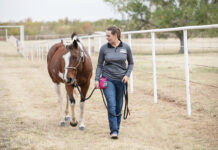You’ve finally met the horse of your dreams, paid a fair price for him, and brought him home. You start working with him and things are coming together nicely. You’re optimistic about the show season ahead. Then, about a month in, he comes up lame and stays there. You try everything your vet suggests, but he never quite gets back to full soundness. What went wrong?

Why Do a Pre-Purchase Exam?
“Most clients buying a very inexpensive horse would ask, ‘Why do I need to do a pre-purchase exam in the first place?'” says Newton. “Horses live right around 30 years, and there’s nothing worse than getting a 4- or 5-year-old horse that’s going to enter into your family, and finding out a year later that he has a significant issue that will prevent you from being able to use him the way you want to.”
Even though you may be willing to keep your horse as a pet for the entirety of his natural life, be realistic about your own riding interests and goals. A horse that you can’t ride has roughly the same monthly expenses as a horse you can ride.
“You’re going to incur significant costs for a horse that you’re getting no use from,” explains Newton. “He’s going to occupy space that could be occupied by a horse that you could benefit from.” If you don’t have the resources to take care of multiple horses, this can put your riding activities on hold for a long time.
“The purpose of the pre-purchase exam is not for me to tell the buyer whether to purchase the horse or not,” Newton continues. “The purpose is to inform the buyer of all the clinical issues that the horse suffers from and try to find any subclinical issues that may affect him in the future.”
The Components of a Pre-Purchase Exam
Newton divides the pre-purchase exam into five different components.
- “The first component is the history,” says Newton. “This includes questions such as: has the horse ever had surgical treatments or significant medical treatments? Has he been treated for EPM (Equine Protozoal Myeloencephalitis), headshaking, or allergies? Has he had acupuncture or chiropractic treatment? And so on. I take a fairly in-depth history, and it shocks me the number of times things [that the buyer wouldn’t otherwise know] are discovered during that history.
- “The second component is a complete physical exam,” says Newton. “I examine the eyes, ears, nose, throat and lungs. I’ll evaluate the neurological status, conformation, hoof quality and care. I’ll see if the skeleton has a limited range of motion.
- “The third component is evaluation of the horse’s movement,” continues Newton. “I’ll evaluate the horse performing the activities for which he is being purchased. If he’s being purchased for Pony Club, for example, I’ll watch him jump small jumps and see him go in a frame. I’ll watch him get tacked up and ridden, which allows a full assessment of behavioral issues as well.
- “Fourth, I’ll perform diagnostics to further evaluate clinical or subclinical problems that were detected previously during the exam,” says Newton. “This might include endoscopy of the upper airway, radiography of the joints, or ultrasound of areas of soft tissue inflammation.”
- “The fifth component might include bloodwork, CBC (complete blood count) chemistry to evaluate organ function, and general state of the white blood count,” says Newton. “Typically, if we’ve found an unsoundness in the horse, the pre-purchase exam then becomes a lameness exam.”
The more in-depth aspects of the exam are entirely at the buyer’s discretion. Someone purchasing an inexpensive horse for low-key trail rides may decide that a more thorough investigation of potential problems isn’t necessary. However, someone investing a substantial amount of money in a horse in hopes of competing in more demanding activities may want to cover all bases before committing to the purchase.
Specialized Testing
If you need your horse to perform spins, rollbacks and sliding stops, you don’t necessarily need to know how he fares over fences. A pre-purchase exam will be most helpful if the vet knows exactly what the buyer intends to do with the horse and can customize the exam accordingly.
“I really like to see the horse performing the activities he’s being purchased for,” says Newton. “I’ll recheck flexion after the horse has done those activities. I certainly encourage more diagnostics on horses being asked to perform at higher levels.”
Your current equestrian activities will dictate most of what you need to know before buying, but Newton explains that most buyers should also think about what they might want in the future.
“There are many times that people are just getting into a sport and they think they want a lower-level horse. But after a few years, they’ve progressed in their riding and they get drawn into higher-level activities, so it’s nice to know [if your horse is physically able to perform at a higher level].”
Judging Conformation
During a pre-purchase exam, your vet can provide some analysis of the horse’s conformation and whether he may be predisposed to problems that will affect your desired use for him in the future.
“I evaluate conformation and use it to paint a broad picture,” says Newton. “Certain conformations predispose a horse to certain unsoundnesses, so we’ll discuss those, but they rarely guarantee problems. We’ll discuss the potential downsides of those conformational deficits, and then we’ll discuss methods to help minimize that effect on long-term soundness.
“You’ll never see me telling somebody not to buy a horse because it’s not conformed well,” adds Newton. “I’ve seen lots of horses with poor conformation go on to do incredible things. Does that mean that they weren’t more predisposed to injury? No, but it also doesn’t mean that they can’t do their job with those conformational problems. But certain care might need to be taken in training. Certain limitations might need to be placed on how often you jump, for example.”
It may seem cold to look at your dream horse through such a clinical lens, but in the long run, knowing as much as you can is in your best interest as well as the horse’s best interest. It can break your heart to walk away from a horse due to a physical problem, but in the end it’s better for him to end up with an owner whose interests match his physical abilities.
“In the horse business, ignorance is rarely bliss,” says Newton. “And knowledge gained from a pre-purchase exam will not always affect whether or not you’ll buy the horse. But it might affect what you’ll pay for the horse, or the way you’ll manage the horse after purchasing him. There are a lot of outcomes to be gained from the pre-purchase exam beyond just whether you buy the horse or not.”
Click here to download a checklist of things to consider during a pre-purchase exam.






Great advice.
My owner didn’t do a pre-purchase on me, but she probably should have!